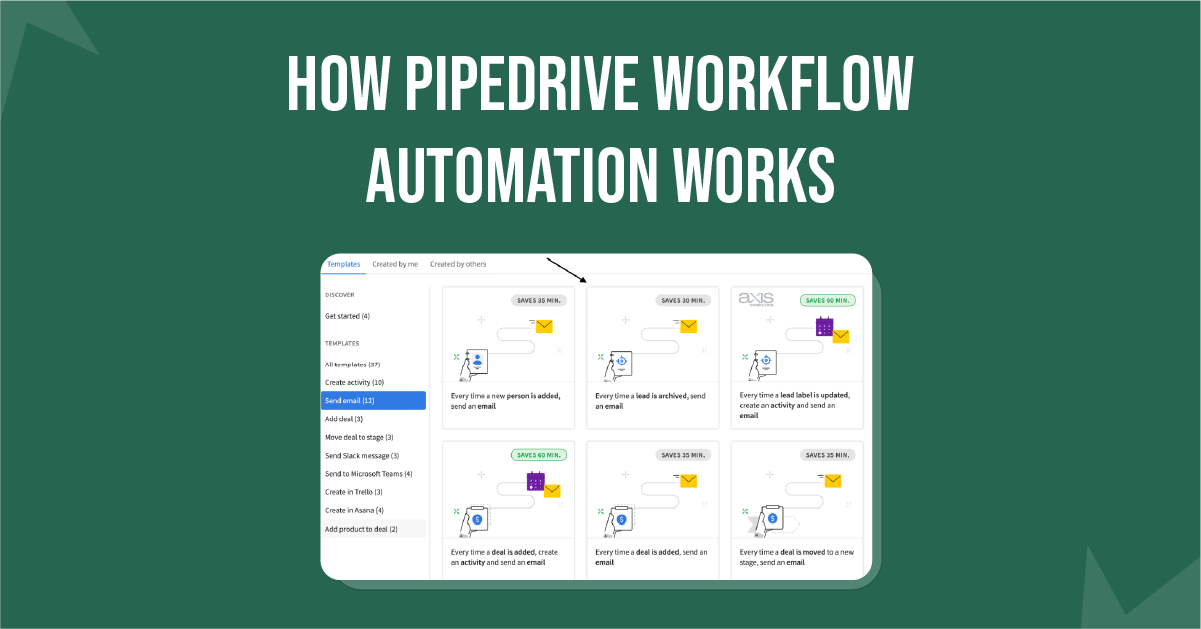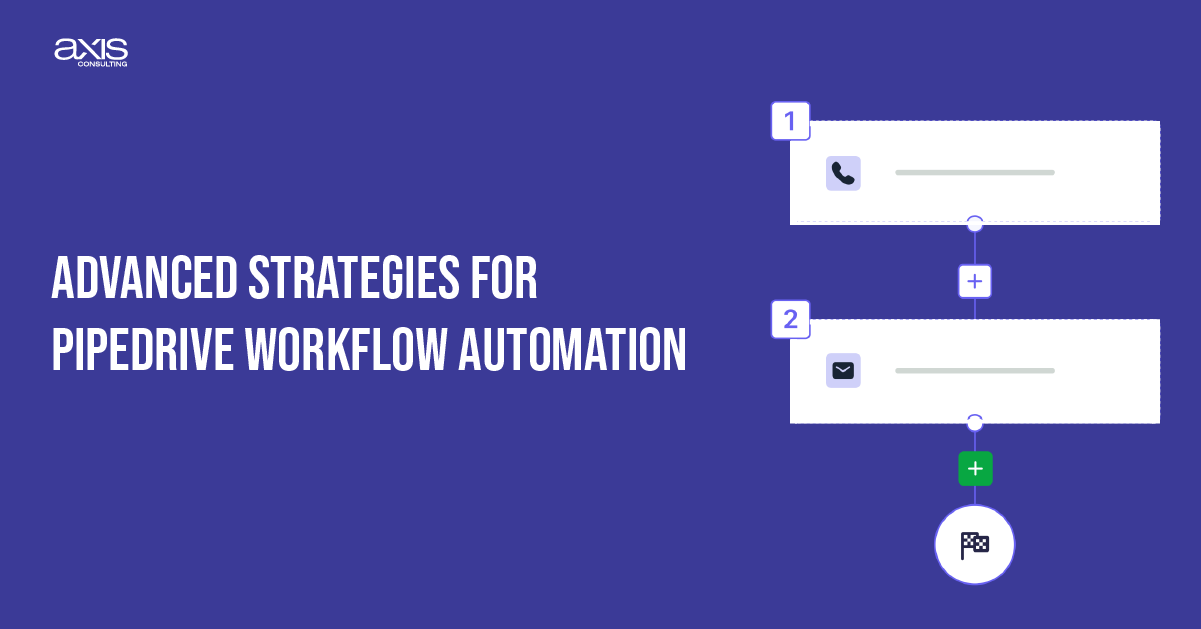Pipedrive Workflow Automation is a powerful tool that helps businesses save time, minimize errors, and streamline their daily tasks. Automating processes like sending emails, updating sales pipelines, and managing customer follow-ups reduces manual work and frees up time for you to focus on growing your business.
This guide will cover everything you need to know about Pipedrive Workflow Automation, from how it works to actionable ways you can use it to boost efficiency. Whether you’re new to Pipedrive or looking to master its features, this guide will help you unlock its full potential and make your workflows smoother and more effective.
Table of Contents
ToggleWhat Is Pipedrive Workflow Automation?
Pipedrive Workflow Automation is a feature in the Pipedrive CRM system that helps you automate repetitive tasks. It works by using triggers and actions to complete tasks automatically. For example, Pipedrive can email the lead, assign the lead to a sales rep, and create a follow-up reminder when you add a new lead to your CRM without lifting a finger.
This automation ensures your team remembers every task and focuses on what they do best: building relationships and closing deals.
How Pipedrive Workflow Automation Works

At its core, Pipedrive Workflow Automation operates using triggers and actions. Triggers are events that start the workflow, like adding a new contact or moving a deal to a different stage in the pipeline. Actions are the tasks that follow, such as sending a welcome email or notifying your team.
For example:
Trigger: The pipeline receives a new deal.
Action 1: The client receives an email introducing your business.
Action 2: A specific sales rep assigns the deal.
Action 3: The system creates a task for the rep to follow up with the client in three days.
The system automatically handles tasks, saving time and ensuring consistency.
Why Should You Use Pipedrive Workflow Automation?
Workflow automation is not about saving time but improving how your business operates. Here are some reasons why you should start using Pipedrive Workflow Automation today:
It Saves Time
Manually performing repetitive tasks takes up a lot of time. For example, sending follow-up emails to leads or updating deal statuses can be tedious and time-consuming. Automation completes these tasks instantly, giving you more time to focus on important work.
It Reduces Mistakes
When humans handle repetitive tasks, mistakes are bound to happen. Someone might forget to send an email or enter the wrong information. Automation ensures correct task completion every time, eliminating these errors.
It Keeps Your Team Organized
With everything automated, you’ll have a clear picture of what’s happening in your sales pipeline. Your team will always know which tasks they have completed and which ones they still need to finish. This clarity helps them stay on top of deadlines and ensures they don’t overlook any leads.
It Boosts Productivity
When small, repetitive tasks don’t bog down your team, they can focus on more strategic work. Sales reps can spend more time building client relationships, and marketers can focus on creating impactful campaigns.
It Grows with Your Business
As your business expands, so do your workflows. Pipedrive can handle increasing tasks and workflows, ensuring that your operations remain smooth even as your team and client base grow.
What Can You Automate with Pipedrive Workflow Automation?
Pipedrive Workflow Automation is flexible, meaning you can use it to automate a variety of tasks across different areas of your business. Here are some examples:
Lead Management
Managing leads can be overwhelming, especially if many come in daily. With Pipedrive, you can automate lead assignments based on specific criteria, such as location or industry. For example, when a lead fills out a contact form on your website, Pipedrive can automatically add the lead to your pipeline, send them a welcome email, and assign them to a sales representative.
Email Follow-Ups
Following up with leads and clients is critical for closing deals, but it’s easy to forget to send that second or third email. Pipedrive can automate email follow-ups based on timelines or actions. For example, if a lead doesn’t respond to your initial email within three days, Pipedrive can send a polite reminder. This ensures that you stay in touch without tracking every lead manually.
Sales Pipeline Updates
Keeping your sales pipeline updated is crucial for tracking progress but can be time-consuming. Pipedrive can update your pipeline automatically as deals move through different stages. For example, when you mark a deal as “won,” Pipedrive updates the pipeline, notifies your team, and creates a task to send the client a thank-you email.
Task Scheduling
Pipedrive can create tasks for your team based on specific actions. For instance, when a deal reaches a particular stage in the pipeline, it can automatically schedule a follow-up call or meeting. This ensures that no opportunity slips through the cracks.
Step-by-Step Guide to Setting Up Pipedrive Workflow Automation

If you’re ready to start using Pipedrive Workflow Automation, here’s a simple step-by-step guide to get you started:
Step 1: Identify Tasks to Automate
Think about the tasks that take up most of your time. These are often repetitive tasks, like sending emails or updating deal statuses. Make a list of these tasks and prioritize which ones to automate first.
Step 2: Access the Workflow Automation Tool
Log in to your Pipedrive account and go to the Workflow Automation section. Here, you can create, edit, and manage your workflows.
Step 3: Set Up a Trigger
Choose what will start your workflow. For example:
Adding a new lead to the CRM
Moving a deal to a new stage
Completing a task
Triggers are the starting points for your automation.
Step 4: Add Actions
Decide what should happen after the trigger. You can add multiple actions, such as:
Sending an email
Assigning the deal to a sales rep
Creating a follow-up task
Each action should align with your business goals.
Step 5: Test Your Workflow
Before you use the workflow, test it to ensure everything works correctly. Ensure that the trigger activates the right actions and processes all data accurately.
Step 6: Activate and Monitor
Once you’re satisfied with the workflow, activate it. Monitor its performance and make adjustments if needed.
Advanced Strategies for Pipedrive Workflow Automation

Once you’ve mastered the basics, you can explore advanced strategies to get more value from Pipedrive Workflow Automation.
Integrate with Other Tools
Pipedrive works well with tools like Slack, Google Sheets, and Trello. For example, you can integrate Pipedrive with Slack to notify your team when you update a deal. This keeps everyone informed and reduces the need for constant check-ins.
Use Templates for Faster Setup
Pipedrive offers workflow templates that can save you time when setting up automations. The templates help with tasks like lead follow-ups, deal updates, and task assignments. Customize them to fit your specific needs.
Leverage Data for Insights
Use Pipedrive’s analytics tools to monitor the performance of your workflows. For example, track how quickly leads are moving through your pipeline or how often follow-up emails result in responses. This data can help you optimize your workflows for better results.
Common Challenges and How to Overcome Them
While Pipedrive Workflow Automation is easy to use, you might encounter some challenges. Here’s how to address them:
Not Knowing What to Automate
If you’re unsure where to start, focus on repetitive tasks that take up much time. Talk to your team to identify tasks they find tedious or time-consuming.
Over-Automating
It’s tempting to automate everything, but not all tasks are suitable for automation. For example, you should handle personal client interactions manually to maintain a human touch. Strike a balance between automation and personalization.
Errors in Workflows
Sometimes, workflows don’t perform as expected. This could be due to incorrect triggers or actions. Regularly review and test your workflows to catch and fix errors.
Conclusion
Pipedrive Workflow Automation is a powerful tool that can transform your business. Automating repetitive tasks, reducing errors, and improving organization helps you save time and achieve more. Whether you’re managing leads, sending follow-ups, or updating pipelines, Pipedrive makes it all easier.
Start using Pipedrive Workflow Automation today and take your business to the next level. With the tips and strategies in this guide, you’ll be well on your way to mastering automation and boosting your productivity.
Frequently Asked Questions
What is Pipedrive Workflow Automation?
Pipedrive Workflow Automation is a feature that automates repetitive tasks like sending emails, updating pipelines, and assigning leads. It helps businesses save time and work more efficiently.
Can I customize workflows in Pipedrive?
Yes, Pipedrive allows you to create custom workflows based on your needs. You can set up triggers and actions to automate tasks that match your business goals.
Does Pipedrive integrate with other tools?
Absolutely! Pipedrive integrates with tools like Slack, Google Sheets, and Trello to enhance your workflows and improve collaboration.